Janaka Wijayakulasooriya
IMU-based Modularized Wearable Device for Human Motion Classification
Mar 29, 2023Abstract:Human motion analysis is used in many different fields and applications. Currently, existing systems either focus on one single limb or one single class of movements. Many proposed systems are designed to be used in an indoor controlled environment and must possess good technical know-how to operate. To improve mobility, a less restrictive, modularized, and simple Inertial Measurement units based system is proposed that can be worn separately and combined. This allows the user to measure singular limb movements separately and also monitor whole body movements over a prolonged period at any given time while not restricted to a controlled environment. For proper analysis, data is conditioned and pre-processed through possible five stages namely power-based, clustering index-based, Kalman filtering, distance-measure-based, and PCA-based dimension reduction. Different combinations of the above stages are analyzed using machine learning algorithms for selected case studies namely hand gesture recognition and environment and shoe parameter-based walking pattern analysis to validate the performance capability of the proposed wearable device and multi-stage algorithms. The results of the case studies show that distance-measure-based and PCA-based dimension reduction will significantly improve human motion identification accuracy. This is further improved with the introduction of the Kalman filter. An LSTM neural network is proposed as an alternate classifier and the results indicate that it is a robust classifier for human motion recognition. As the results indicate, the proposed wearable device architecture and multi-stage algorithms are cable of distinguishing between subtle human limb movements making it a viable tool for human motion analysis.
Hybrid Y-Net Architecture for Singing Voice Separation
Mar 05, 2023Abstract:This research paper presents a novel deep learning-based neural network architecture, named Y-Net, for achieving music source separation. The proposed architecture performs end-to-end hybrid source separation by extracting features from both spectrogram and waveform domains. Inspired by the U-Net architecture, Y-Net predicts a spectrogram mask to separate vocal sources from a mixture signal. Our results demonstrate the effectiveness of the proposed architecture for music source separation with fewer parameters. Overall, our work presents a promising approach for improving the accuracy and efficiency of music source separation.
Assessment of Fetal and Maternal Well-Being During Pregnancy Using Passive Wearable Inertial Sensor
Nov 19, 2021



Abstract:Assessing the health of both the fetus and mother is vital in preventing and identifying possible complications in pregnancy. This paper focuses on a device that can be used effectively by the mother herself with minimal supervision and provide a reasonable estimation of fetal and maternal health while being safe, comfortable, and easy to use. The device proposed uses a belt with a single accelerometer over the mother's uterus to record the required information. The device is expected to monitor both the mother and the fetus constantly over a long period and provide medical professionals with useful information, which they would otherwise overlook due to the low frequency that health monitoring is carried out at the present. The paper shows that simultaneous measurement of respiratory information of the mother and fetal movement is in fact possible even in the presence of mild interferences, which needs to be accounted for if the device is expected to be worn for extended times.
Comprehensive Study on Denoising of Medical Images Utilizing Neural Network Based Auto-Encoder
Feb 03, 2021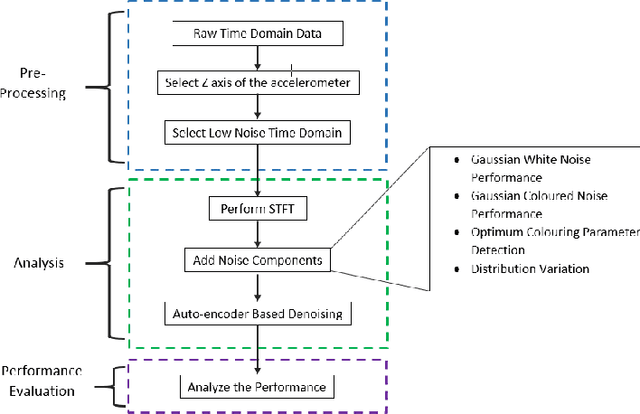
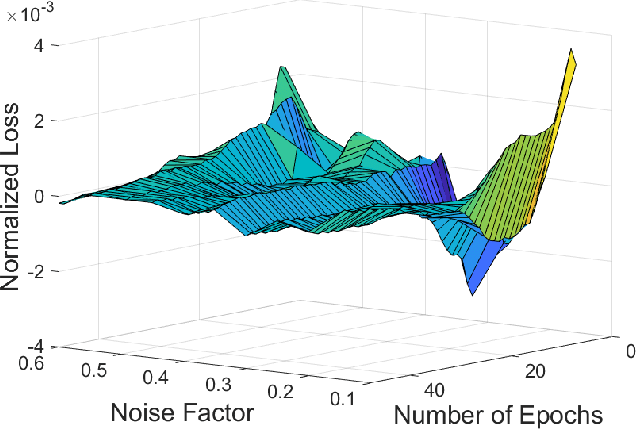
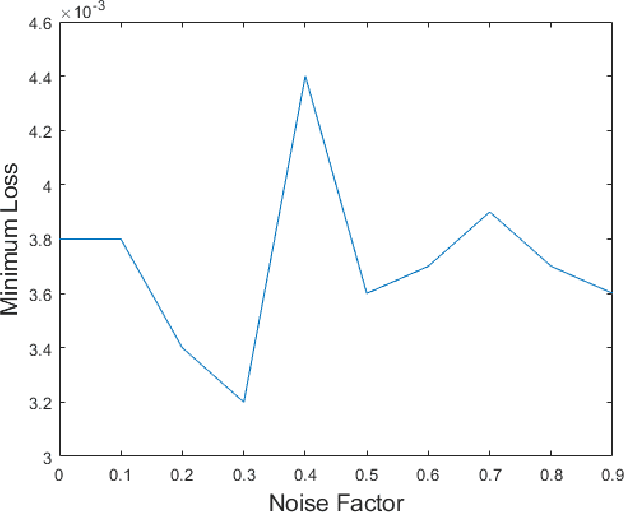
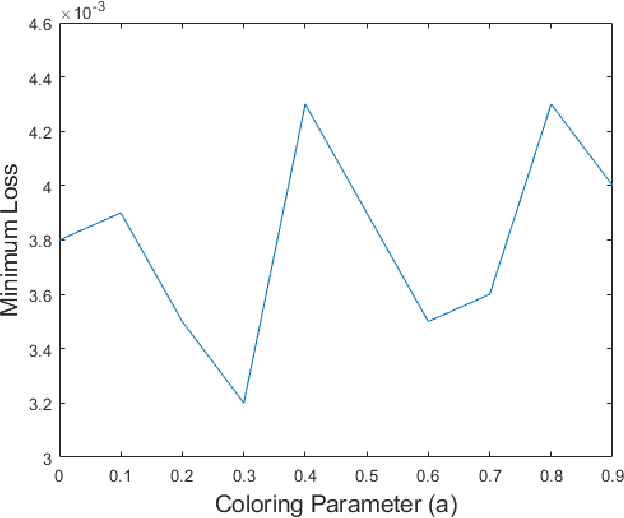
Abstract:Fetal motion discernment utilizing spectral images extracted from accelerometric data incident on pregnant mothers abdomen has gained substantial attention in the state-of-the-art research. It is an essential practice to avoid adverse scenarios such as stillbirths and intrauterine growth restrictions. However, this endeavor of ensuring fetus safety has been arduous due to the existence of random noise in medical images. This novel research is an in depth approach to analyze how the interference of different noise variations affect the retrieval of information in those images. For that, an algorithm employing auto-encoder-based deep learning was modeled and the accuracy of reconstruction of the STFT images mitigating the noise has been measured examining the loss. From the results, it is manifested that even a substantial addition of the Super-Gaussian noises which have a higher correlation of the frequencies possessed by the Fetal movement images can be restored successfully with the slightest error.
Novel Non-Invasive In-house Fabricated Wearable System with a Hybrid Algorithm for Fetal Movement Recognition
Jan 29, 2021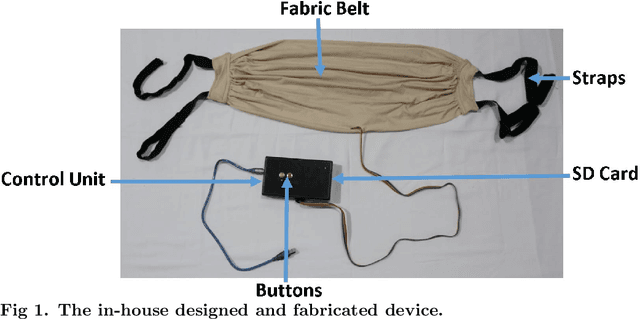

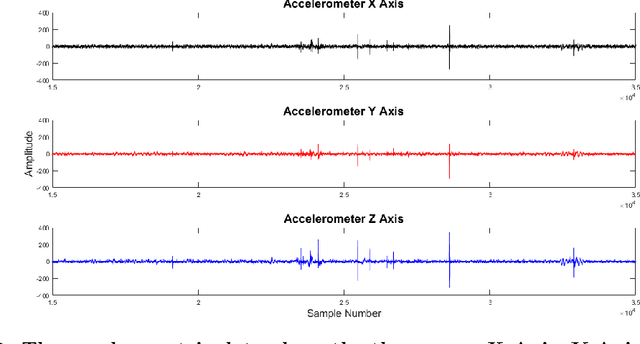

Abstract:Fetal movement count monitoring is one of the most commonly used methods of assessing fetal well-being. While few methods are available to monitor fetal movements, they consist of several adverse qualities such as unreliability as well as the inability to be conducted in a non-clinical setting. Therefore, this research was conducted to design a complete system that will enable pregnant mothers to monitor fetal movement at home. This system consists of a non-invasive, non-transmitting sensor unit that can be fabricated at a low cost. An accelerometer was utilized as the primary sensor and a micro-controller based circuit was implemented. Clinical testing was conducted utilizing this sensor unit. Two phases of clinical testing procedures were done and readings from more than 120 pregnant mothers were taking. Validation was done by conducting an abdominal ultrasound scan which was utilized as the ground truth during the second phase of the clinical testing procedure. A clinical survey was also conducted in parallel with clinical testings in order to improve the sensor unit as well as to improve the final system. Four different signal processing algorithms were implemented on the data set and the performance of each was compared with each other. Consequently, the most feasible as well as the best performing algorithm was determined and it was utilized in the final system. Furthermore, a mobile application was also developed to be used with the sensor unit by pregnant mothers. Finally, a complete end to end method to monitor fetal movement in a non-clinical setting was presented by the proposed system.
 Add to Chrome
Add to Chrome Add to Firefox
Add to Firefox Add to Edge
Add to Edge